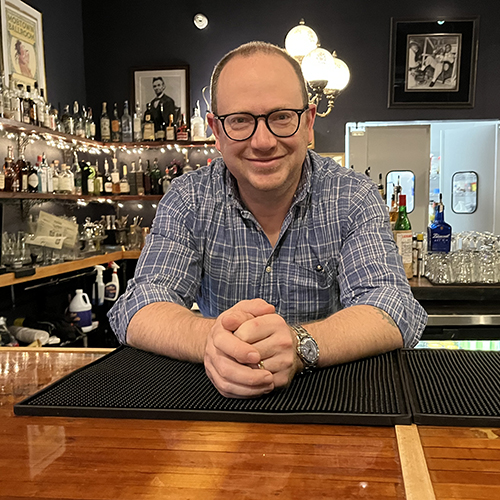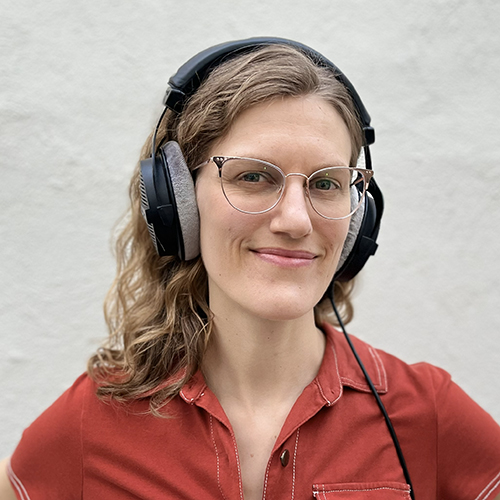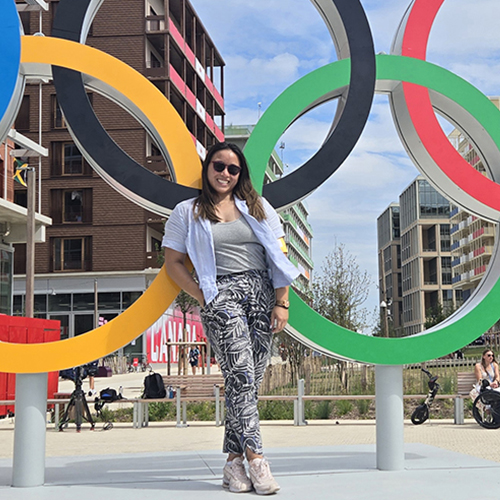Marcin Pączkowski (MM, Composition, 2011) stands on stage facing the audience, his gloved hands tracing graceful circles in the air as music flows from nearby speakers. Suddenly his left hand shakes with an exaggerated tremor, causing the music to flutter. His right hand punches the air and a deep tone sounds, as if by magic. But Pączkowski is not a magician. He is a composer and conductor who uses technology to explore musical possibilities.
In his current work, Pączkowski uses wireless sensors, attached to his palms, to alter sounds. Individual gestures trigger specific musical changes, such as adding a layer of instrumentation or creating a “scratch” effect similar to a DJ scratching a record on a turntable. Using dozens of gestures that generate programmed responses, Pączkowski is able to shape music in real time.
Born and raised in Poland, Pączkowski has been interested in both music and computers since childhood. But he saw no way to combine the two until discovering the Electroacoustic Music Studio at the Academy of Music in Krakow, where he earned master’s degrees in composition and conducting. His interest in music and technology intensified at the UW, where he earned a second master’s in composition and is now a doctoral candidate in the Center for Digital Arts and Experimental Media (DXARTS).

“I’m intrigued by the possibilities of creating something that’s not possible to create any other way,” says Pączkowski of his use of technology in music. “That’s the most important thing. It’s also a way to explore both interests at the same time.”
Pączkowski began using motion sensors, known as accelerometers, about three years ago. The technology has been around a while — choreographer Merce Cunningham used analog accelerometers in a dance performance way back in 1972 — but today’s sensors are far more sophisticated. The first piece Pączkowski composed using an accelerometer was a collaboration with a dancer; he has since composed a piece for a seven-member ensemble, a percussion solo, and a work he performs himself without an instrument.
When Pączkowski performs, his fluid and dramatic arm movements hint at his background in conducting. For the past few years he has conducted the UW School of Music Modern Ensemble and a community orchestra in Everett, Washington, but there has been little connection between his conducting and composition work — until now. “Using the sensors is a way for me to reintroduce some of the performative aspects of conducting into my creative work, using movements that are heavily rooted in my conducting practice,” he says. “The performance is somewhere between conducting and playing this invisible instrument.”
I’m intrigued by the possibilities of creating something that’s not possible to create any other way.
Having programmed his accelerometers, Pączkowski is skilled at gesturing to achieve a desired effect. But when other musicians use the sensors, things get more complicated, as he discovered last fall when Chicago-based Ensemble Dal Niente performed one of his compositions during a weeklong residency at the UW. Each ensemble member wore an accelerometer during the performance, with Pączkowski fine-tuning the electronics in rehearsals to accommodate the musicians’ individual styles of movement. “Tweaking is not as immediate as turning a knob on a mixer,” says Paczkowski, “because there are hundreds of ‘knobs’ buried down in code — parameters that you need to adjust to make them properly respond to what performers are doing. It was a collaboration to fine-tune the interactions. Fortunately the musicians were very willing to try new things.”
Audiences attending Pączkowski’s concerts should also be willing to try new things. New music can sometimes be challenging because it is unfamiliar, though Paczkowski finds that there are certain constants in all music. “For people who are not familiar with this music, it helps to find the connection between what they already know about music and what’s happening in the new music,” he says. “The processes and relationships are quite similar across genres. They’re just expressed through a different language.”
Those interested in hearing — and seeing — Pączkowski’s work will have two opportunities this spring. In April, Pączkowski will be among the featured composers at a DXARTS concert in Meany Hall. In May he will present a recital of his work, including the percussion, ensemble, and solo pieces that use accelerometers, in a more intimate performance space. (See sidebar for details.)
What’s next for the forward-thinking composer? “I plan to write another percussion piece this spring that will use movement in more precise ways, and I’ve started working on a piece that might involve a dancer too,” says Pączkowski. “There are things I want to push further, make sound better, be more responsive, more performative, more expressive, more musical. There are so many possibilities waiting to be refined or explored.”
More Stories

A Love of Classics and Ballroom
Michael Seguin studied Classics at the UW and now owns Baltimore's Mobtown Ballroom. The two interests, he says, are more connected than they might seem.

Bringing Music to Life Through Audio Engineering
UW School of Music alum Andrea Roberts, an audio engineer, has worked with recording artists in a wide range of genres — including Beyoncé.

A Sports Obsession Inspires a Career
Thuc Nhi Nguyen got her start the UW Daily. Now she's a sports reporter for Los Angeles Times, writing about the Lakers and the Olympics.